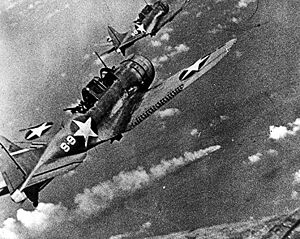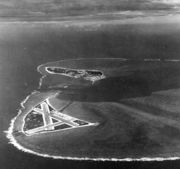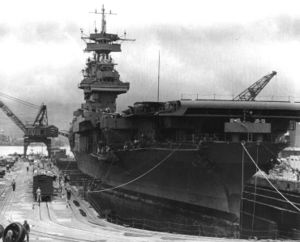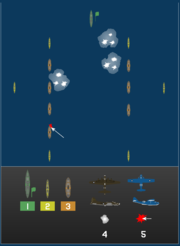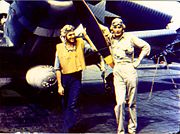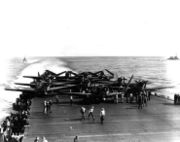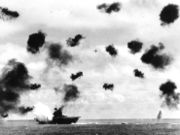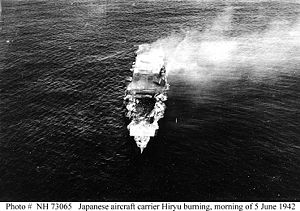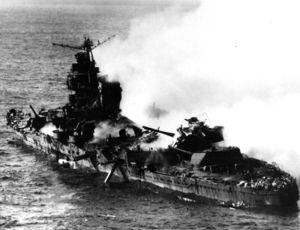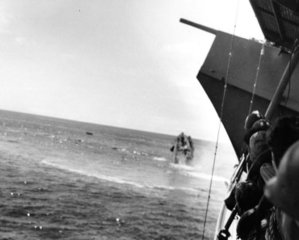Battle of Midway
2008/9 Schools Wikipedia Selection. Related subjects: World War II
|
||||||||||||||||||||||||||||||
|
||||||||||||||||||||||||||||||
|
||||||||||||||||||||||||||||||
The Battle of Midway was a major naval battle in the Pacific Theatre of World War II. It took place from June 4, 1942 to June 7, 1942, approximately one month after the Battle of the Coral Sea, about five months after the Japanese capture of Wake Island, and six months after the Empire of Japan's attack on Pearl Harbour that had led to a formal state of war between the United States and Japan. During the battle, the United States Navy defeated a Japanese attack against Midway Atoll, losing one aircraft carrier and one destroyer, while destroying four Japanese carriers and a heavy cruiser.
The battle was a decisive victory for the Americans, widely regarded as the most important naval engagement of the Pacific Campaign of World War II. The battle permanently weakened the Imperial Japanese Navy (IJN), in particular through the loss of four fleet carriers and over 200 naval aviators.
Both nations sustained losses in the battle, but Japan was unable to reconstitute her naval forces, while the American shipbuilding and aircrew training programs provided quick replacements. By 1942, the United States was three years into a massive ship building program intended to expand the Navy to a size superior to Japan's. As a result of Midway, the Japanese were faced with naval inferiority within months. Strategically, the U.S. Navy was able to seize the initiative in the Pacific and go on the offensive.
The Japanese plan of attack was to lure America's remaining carriers into a trap and sink them. The Japanese also intended to occupy Midway Atoll to extend Japan's defensive perimeter farther from its home islands. This operation was considered preparatory for further attacks against Fiji and Samoa, as well as an invasion of Hawaii.
The Midway operation, like the attack on Pearl Harbour, was not part of a campaign for the conquest of the United States, but was aimed at its elimination as a strategic Pacific power, thereby giving Japan a free hand in establishing its Greater East Asia Co-Prosperity Sphere. It was also hoped another defeat would force the U.S. to negotiate an end to the Pacific War with conditions favorable for Japan.
Strategic context
Japan had been highly successful in rapidly securing its initial war goals, including the takeover of the Philippines, capture of Malaya and Singapore, and securing vital resource areas in Java, Borneo, and other islands of the Dutch East Indies (now Indonesia). As such, preliminary planning for a second phase of operations commenced as early as January 1942. However, because of strategic differences between the Imperial Army and Imperial Navy, as well as infighting between the Navy's GHQ and Admiral Isoroku Yamamoto’s Combined Fleet, the formulation of effective strategy was hampered, and the follow-up strategy was not finalized until April 1942. Admiral Yamamoto succeeded in winning a bureaucratic struggle placing his operational concept — further operations in the Central Pacific — ahead of other contending plans. These included operations either directly or indirectly aimed at Australia and into the Indian Ocean. In the end, Yamamoto's barely-veiled threat to resign unless he got his way succeeded in carrying his agenda forward.
Yamamoto's primary strategic concern was the elimination of America's remaining carrier forces. This concern was acutely heightened by the Doolittle Raid on Tokyo ( April 18, 1942) by USAAF B-25s, launching from USS Hornet. The raid, while militarily insignificant, was a severe psychological shock to the Japanese and proved the existence of a gap in the defenses around the Japanese home islands. Sinking America's aircraft carriers and seizing Midway, the only strategic island besides Hawaii in the East Pacific, was seen as the only means of nullifying this threat. Yamamoto reasoned an operation against the main carrier base at Pearl Harbour would induce the U.S. forces to fight. However, given the strength of American land-based air-power on Hawaii, he judged the powerful American base could not be attacked directly. Instead, he selected Midway, at the extreme northwest end of the Hawaiian Island chain, some 1,300 miles (2,100 km) from Oahu. Midway was not especially important in the larger scheme of Japan's intentions; however, the Japanese felt the Americans would consider Midway a vital outpost of Pearl Harbour and would therefore strongly defend it. The U.S. did consider Midway vital; after the battle, establishment of a U.S. submarine base on Midway extended submarine range 2,400 miles (4,400 km). An airstrip on Midway served as a forward staging point for bomber attacks on Wake Island.
Yamamoto's plan
Typical of Japanese naval planning during the Second World War, Yamamoto's battle plan was quite complex. Additionally, his designs were predicated on optimistic intelligence information suggesting USS Enterprise and USS Hornet, forming Task Force 16, were the only carriers available to the U.S. Pacific Fleet at the time. USS Lexington had been sunk and USS Yorktown severely damaged (and IJN believed her sunk) at the Battle of the Coral Sea just a month earlier. Likewise, the Japanese were aware USS Saratoga was undergoing repairs on the West Coast after taking torpedo damage from a submarine. As such, the Japanese believed they faced at most two American fleet carriers at the point of contact.
More important, however, was Yamamoto's belief the Americans had been demoralized by their frequent defeats during the preceding six months. Yamamoto felt deception would be required to lure the U.S. Fleet into a fatally compromising situation. To this end, he dispersed his forces so their full extent (particularly his battleships) would be unlikely to be discovered by the Americans prior to battle. However, his emphasis on dispersal meant none of his formations were mutually supporting. Unbeknownst to Yamamoto, any benefit from this was neutralized by the fact the United States had broken the main Japanese naval code (dubbed JN-25 by the U.S.).
Critically, Yamamoto's supporting battleships and cruisers would trail Vice-Admiral Chuichi Nagumo's carrier striking force by several hundred miles. Japan's heavy surface forces were intended to destroy whatever part of the U.S. Fleet might come to Midway's relief, once Nagumo's carriers had weakened them sufficiently for a daylight gun duel to be fought; this was typical of the battle doctrine of most major navies. However, their distance from Nagumo's carriers would have grave implications during the battle, since the battleships were escorted by cruisers, which possessed scout planes invaluable to Nagumo.
Aleutian invasion
Likewise, the Japanese operations aimed at the Aleutian Islands (Operation AL) removed yet more ships from the force striking Midway. However, whereas prior histories of the battle have often characterized the Aleutians operation as a feint to draw American forces northwards, recent scholarship on the battle has shown, by the original Japanese battle plan, AL was designed to be launched simultaneously with the attack on Midway. However, a one-day delay in the sailing of Nagumo's task force had the effect of initiating Operation AL a day before its counterpart.
Order of battle
Prelude to battle
U.S. forces
In order to do battle with an enemy force anticipated to be composed of 4 or 5 carriers, Admiral Chester W. Nimitz, Commander in Chief, Pacific Ocean Areas, needed every available U.S. flight deck. He already had Vice Admiral William Halsey's two-carrier task force at hand — but Halsey was stricken with psoriasis and had to be replaced with Rear Admiral Raymond A. Spruance (Halsey's escort commander). Nimitz also hurriedly called back Rear Admiral Frank Jack Fletcher's task force from the South West Pacific Area. He reached Pearl Harbour just in time to provision and sail. Saratoga was still under repair, and Yorktown had been severely damaged at the Battle of the Coral Sea, but Pearl Harbour Naval Shipyard worked around the clock to patch up the carrier. Though several months of repairs at Puget Sound Naval Shipyard was estimated for Yorktown, 72 hours was enough to restore her to a battle-worthy (if still not structurally ideal) state. Her flight deck was patched, whole sections of internal frames were cut out and replaced, and several new squadrons (drawn from the Saratoga) were put aboard. Nimitz showed disregard for established procedure in getting his third and last available carrier ready for battle — repairs continued even as Yorktown sortied, with work crews from the repair ship USS Vestal—herself damaged in the attack on Pearl Harbor six months earlier—still aboard. Just three days after putting into drydock at Pearl Harbour, Yorktown was again under steam.
Japanese forces
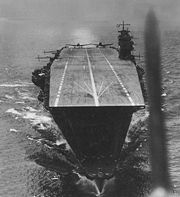
Meanwhile, as a result of their participation in the Battle of the Coral Sea, the Japanese carrier Zuikaku was in port in Kure, awaiting a replacement air group. The heavily damaged Shōkaku was under repair from three bomb hits suffered at Coral Sea, and required months in drydock. Despite the likely availability of sufficient aircraft between the two ships to re-equip Zuikaku with a composite air group, the Japanese made no serious attempt to get her into the forthcoming battle. Consequently, instead of bringing five intact fleet carriers into battle, Admiral Nagumo would only have four: Kaga, with Akagi, forming Division 1; Hiryū and Sōryū, as the 2nd Division. At least part of this was a product of fatigue; Japanese carriers had been constantly on operations since December 7, 1941, including pinprick raids on Darwin and Colombo.
Japanese strategic scouting arrangements prior to the battle also fell into disarray. A picket line of Japanese submarines was late getting into position (partly because of Yamamoto's haste), which let the American carriers proceed to their assembly point northeast of Midway (known as "Point Luck") without being detected. A second attempt to use four-engine reconnaissance flying boats to scout Pearl Harbour prior to the battle (and thereby detect the absence or presence of the American carriers), known as "Operation K", was also thwarted when Japanese submarines assigned to refuel the search aircraft discovered the intended refueling point — a hitherto deserted bay off French Frigate Shoals — was occupied by American warships (because the Japanese had carried out an identical mission in March). Thus, Japan was deprived of any knowledge concerning the movements of the American carriers immediately before the battle. Japanese radio intercepts also noticed an increase in both American submarine activity and U.S. message traffic. This information was in Yamamoto's hands prior to the battle. However, Japanese plans were not changed in reaction to this; Yamamoto, at sea in Yamato, did not dare inform Nagumo without exposing his position, and presumed (incorrectly) Nagumo had received the same signal from Tokyo.
American and British code-breaking
Admiral Nimitz had one priceless asset: American and British cryptanalysts had broken the JN-25 code. Commander Joseph J. Rochefort and his team at HYPO were able to confirm Midway as the target of the impending Japanese strike, to determine the date of the attack as either 4 or 5 June (as opposed to mid-June, maintained by Washington), and to provide Nimitz with a complete IJN order of battle. Japan's efforts to introduce a new codebook had been delayed, giving HYPO several crucial days; while it was blacked out shortly before the attack began, the important breaks had already been made.
As a result, the Americans entered the battle with a very good picture of where, when, and in what strength the Japanese would appear. Nimitz was aware, for example, the vast numerical superiority of the Japanese fleet had been divided into no less than four task forces, and the escort for the main Carrier Striking Force was limited to just a few fast ships. For this reason, they knew the anti-aircraft guns protecting the carriers would be limited. Knowing the strength he faced, Nimitz calculated his three carrier decks, plus Midway, to Yamamoto's four, gave the U.S. rough parity. (It is also true American carrier air groups were larger than Japanese ones.) The Japanese, by contrast, remained almost totally in the dark about their opponents even after the battle began.
Battle
Initial air attacks
The first air attack occurred on June 4, by 9 B-17s operating from Midway against the Japanese transport group. Though hits were reported, none of the bombs actually landed on target and no significant damage was sustained. Early the following morning, Akebono Maru sustained the first hit when a torpedo from an attacking PBY struck her around 01:00. Vice Admiral Chuichi Nagumo launched his initial attack wave (108 aircraft) at 04:30 on June 4. At the same time, he launched eight search aircraft (one 30 minutes late due to technical issues, and one which was forced to turn back), as well as his combat air patrol.
Japanese reconnaissance arrangements were flimsy, with too few aircraft to adequately cover the assigned search areas, laboring under poor weather conditions to the northeast and east of the task force. Now, Yamamoto's faulty dispositions came home to roost.
American radar picked up the enemy at a distance of several miles and interceptors soon scrambled. Unescorted bombers headed off to attack the Japanese carrier fleet, their fighter escorts remaining behind to defend Midway. At 06:20, Japanese carrier aircraft bombed and heavily damaged the U.S. base on Midway. Midway-based Marine fighter pilots, flying obsolescent Grumman F4F Wildcats and obsolete Brewster F2As, made a defense of Midway and suffered heavy losses. Most were downed in the first few minutes, and only two remained flyable. American anti-aircraft fire was accurate and intense, damaging many Japanese aircraft and claiming a third of the Japanese planes destroyed. The Japanese learned the island's bombers had already departed, and the strike leader signaled Nagumo another attack would be necessary to neutralize Midway's defenses before troops could be landed on June 7; American bombers still could use the airbase to refuel and attack the Japanese invasion force.
Having taken off prior to the Japanese attack, American bombers based on Midway made several attacks on the Japanese carrier fleet. These included six TBF Avengers composed of pilots from Hornet's VT-8 in their first combat operation, and four USAAC B-26 Marauders, all armed with torpedoes. The Japanese shrugged off these attacks with almost no losses, while destroying all but three of the American bombers, which were one TBF and two B-26s.
Admiral Nagumo, in accordance with Japanese carrier doctrine at the time, had kept half of his aircraft in reserve. These comprised two squadrons each of dive-bombers and torpedo bombers, the torpedo bombers armed with torpedoes, should any American warships be located. The dive bombers were, as yet, unarmed. As a result of the attacks from Midway, as well as the morning flight leader's recommendation regarding the need for a second strike, Nagumo at 07:15 ordered his reserve planes to be re-armed with general purpose contact bombs for use on land targets. This had been underway for about 30 minutes, when at 07:40 a scout plane from the cruiser Tone signaled the discovery of a sizable American naval force to the east. Nagumo quickly reversed his order and demanded the scout plane ascertain the composition of the American force. Another 40 minutes elapsed before Tone's scout finally detected and radioed the presence of a single carrier in the American force, TF 16 (the other carrier was not detected).
Nagumo was now in a quandary. Rear Admiral Tamon Yamaguchi, leading Carrier Division 2 (Hiryū and Sōryū), recommended Nagumo strike immediately with the forces at hand. Nagumo's seeming opportunity to hit the American ships, however, was curtailed by the fact his Midway strike force would be returning shortly. They would be low on fuel and carrying wounded crewmen, would need to land promptly or ditch, losing precious aircraft and crews; there was slim chance a strike could be mounted in time. Spotting his flight decks and launching aircraft would require at least 30–45 minutes. Furthermore, by spotting and launching immediately, he would be committing some of his reserve to battle without proper anti-ship armament, as well as without fighter escort; they had just witnessed how easily unescorted American bombers were shot down by their own fighters . Japanese carrier doctrine preferred fully constituted strikes, and in the absence of a confirmation (until 08:20) of whether the American force contained carriers, Nagumo's reaction was doctrinaire. In addition, the impending arrival of another American air strike at 07:53 gave weight to the need to attack the island again. In the end, Nagumo chose to wait for his first strike force to land, then launch the reserve force, which would have by then been properly armed and ready. In the final analysis, it made no difference; Fletcher had launched beginning at 07:00, so the aircraft which would deliver the crushing blow were already on their way. There was nothing Nagumo could do about it. This was the fatal flaw of Yamamoto's dispositions: it followed strictly traditional battleship doctrine.
Attacks on the Japanese fleet
Meanwhile, the Americans had already launched their carrier aircraft against the Japanese. Admiral Fletcher, in overall command aboard Yorktown, and armed with PBY patrol bomber sighting reports from the early morning, ordered Spruance to launch against the Japanese as soon as was practical. Spruance gave the order "Launch the attack" at around 06:00 and left Halsey's Chief of Staff, Captain Miles Browning, to work out the details and oversee the launch. It took until a few minutes after 07:00 before the first plane was able to depart from Spruance's carriers, Enterprise and Hornet. Fletcher, upon completing his own scouting flights, followed suit at 08:00 from Yorktown. It was at this point Spruance gave his second crucial command, to run toward the target, having judged the need to throw something at the enemy as soon as possible was greater than the need for a coordinated attack among the different types of aircraft (fighters, bombers, torpedo planes). Accordingly, American squadrons were launched piecemeal, proceeding to the target in several different groups. This diminished the overall impact of the American attacks and greatly increased their casualties; coincidentally, it reduced the Japanese ability to counterstrike and found Nagumo with his decks at their most vulnerable.
American carrier aircraft had difficulty locating the target in the vastness of the Pacific, despite the positions they had been given. Nevertheless, they did finally sight enemy carriers and began attacking at 09:20, led by Torpedo Squadron 8 ( VT-8, from Hornet), followed by VT-6 (from Enterprise) at 09:40. Every TBD Devastator of VT-8 was shot down, with only one survivor. VT-6 squadron met nearly the same fate, with no hits against the enemy to show for their efforts, thanks in part to terrible aircraft torpedoes. The Japanese CAP, flying the much faster Mitsubishi Zero, made short work of the Americans, who not only had no fighter support of their own but were flying the slow, under-armed TBDs. However, despite their losses, the American torpedo planes indirectly achieved three important results. First, they kept the Japanese carriers off balance, with no ability to prepare and launch their own counterstrike. Second, their attacks had pulled the Japanese combat air patrol out of position. Third, many of the Zeros were low on ammunition and fuel. The appearance of a third torpedo plane attack from the southeast by VT-3 at 10:00 very quickly drew the majority of the Japanese CAP into the southeast quadrant of the fleet.
By chance, at the same time VT-3 was sighted by the Japanese, two separate formations (comprising three squadrons total) of American SBD Dauntless dive-bombers were approaching the Japanese fleet from the northeast and southwest. These formations initially had difficulty in locating the Japanese carriers, and their fuel was running low. However, by the decisions of squadron commanders C. Wade McClusky, Jr. and Max Leslie to continue the search, they spotted the wake of Japanese destroyer Arashi. The destroyer was steaming at full speed back to Nagumo's carrier force, after having unsuccessfully depth-charged the U.S. submarine Nautilus (SS-168), which had earlier carried out an unsuccessful attack on the battleship Kirishima. The American dive-bombers arrived in a perfect position to attack the Japanese. Armed Japanese strike aircraft filled the hangar decks at the time of the fateful attack, fuel hoses were snaking across the decks as refueling operations were hastily completed, and the constant change of ordnance meant bombs and torpedoes were stacked around the hangars rather than stowed safely in the magazines. The Japanese carriers were extraordinarily vulnerable.
Contrary to some accounts of the battle, contemporary research, based on recent translation of relevant portions of the 100 volume Japanese account of the war, Senshi Sōshō, has demonstrated the Japanese were not in fact prepared to launch a counterstrike against the Americans at the time they were decisively attacked. Because of the constant flight deck activity associated with combat air patrol operations during the preceding hour, the Japanese had never had an opportunity to spot their reserve for launch. The few aircraft on the Japanese flight decks at the time of the attack were either CAP fighters, or (in the case of Sōryū) strike fighters being spotted to augment the CAP. Regardless, the moment of opportunity was exploited extensively by the American bomber pilots.
Beginning at 10:22, Enterprise’s aircraft attacked Kaga, while to the south, Yorktown’s aircraft attacked carrier Sōryū, with Akagi being struck by several of Enterprise's bombers four minutes later. Simultaneously, VT-3 was targeting Hiryū, although the American torpedo aircraft again scored no hits. The dive-bombers, however, had better fortune. Within six minutes, the SBD dive bombers made their attack runs and left all three of their targets heavily ablaze. Akagi was hit by just one bomb, which was sufficient; it penetrated to the upper hangar deck and exploded among the armed and fueled aircraft there. One extremely near miss also slanted in and exploded underwater, bending the flight deck upward with the resulting geyser and causing crucial rudder damage. Sōryū took three bomb hits in the hangar decks; Kaga took at least four, possibly more. All three carriers were out of action and would eventually be abandoned and scuttled.
By proceeding to target directly, without waiting for fighter escort, the torpedo squadrons, one after another, at low level, engaged enemy combat air patrol. This created an opportunity for the pilots of the dive bombers, who had arrived high above the action and were able to dive on target before being attacked. The torpedo planes were shot down and the torpedo squadron pilots lost their lives, but they enabled a titanic victory.
Subsequent to the air attacks, Nautilus fired torpedoes at what her crew thought was Sōryū but which later research suggests was Kaga. Nautilus claimed one hit the carrier, causing "flames". However, the surviving crew of Kaga reported no torpedo hits after the air attack. Of the four torpedoes launched, one failed to run, two ran erratically, and the fourth was a 'dud', impacting amidships and breaking in half. History would show Nautilus had already made a more important contribution.
Japanese counterattacks
Hiryū, the sole surviving Japanese aircraft carrier, wasted little time in counterattacking. The first wave of Japanese dive-bombers badly damaged Yorktown with two bomb hits, yet her damage control teams patched her up so effectively (in about an hour) the second wave's torpedo bombers mistook her for an intact carrier. Despite Japanese hopes to even the battle by eliminating two carriers with two strikes, Yorktown absorbed both Japanese attacks, the second mistakenly believing Yorktown had already been sunk and they were attacking Enterprise. After two torpedo hits, Yorktown lost power and was now out of the battle, forcing Admiral Fletcher to move his flag to the heavy cruiser Astoria, but Task Force 16's two carriers had escaped undamaged as a result.
News of the two strikes, with the reports each had sunk an American carrier, greatly improved the morale of the crewmen of the Kido Butai. Its surviving aircraft all recovered aboard Hiryū, where they were prepared for a strike against what was believed to be the only remaining American carrier.
When American scout aircraft subsequently located Hiryū late in the afternoon, Enterprise launched a final strike of dive bombers (including 10 bombers from Yorktown), leaving Hiryū ablaze, despite being defended by a strong defensive CAP of over a dozen Zero fighters. Rear Admiral Yamaguchi chose to go down with his ship, costing Japan perhaps her best carrier sailor. Hornet's strike, launching late because of a communications error, concentrated on the remaining surface ships but failed to score any hits.
As darkness fell, both sides took stock and made tentative plans for continuing the action. Admiral Fletcher, obliged to abandon the derelict Yorktown and feeling he could not adequately command from a cruiser, ceded operational command to Spruance. Spruance knew the United States had won a great victory, but was still unsure of what Japanese forces remained at hand and was determined to safeguard both Midway and his carriers. To aid his aviators, who had launched at extreme range, he had continued to close Nagumo during the day, and persisted as night fell. Fearing a possible night encounter with Japanese surface forces, Spruance changed course and withdrew to the east, turning back west towards the enemy at midnight.
For his part, Yamamoto initially decided to continue the effort and sent his remaining surface forces searching eastward for the American carriers. Simultaneously, a cruiser raiding force was detached to bombard the island. The Japanese surface forces failed to make contact with the Americans due to Spruance's decision to briefly withdraw eastward, and Yamamoto ordered a general retirement to the west.
American search planes failed to detect the retiring Japanese task forces on June 5. An afternoon strike narrowly missed detecting Yamamoto's main body and failed to score hits on a straggling Japanese destroyer. The strike planes returned to the carriers after nightfall, prompting Spruance to order Enterprise and Hornet to turn on searchlights in order to aid their landings. Marc Mitscher, commanding Hornet, would later issue the same order under similar circumstances during the Battle of the Philippine Sea.
At 02.15 on 5–6 June, Commander John Murphy's Tambor, lying some 90mi (165km) west of Midway, made one of the Submarine Force's two major contributions to the battle's outcome, sighting several ships. He (along with his exec, Ray Spruance, Jr.) could not identify them (and feared they might be friendly, so he held fire), but reported their presence, omitting their course. This went to Admiral Robert English, Commander, Submarine Force, Pacific Fleet (COMSUBPAC), and from him through Nimitz to the senior Spruance. Unaware of the exact location of Yamamoto's "Main Body" (a persistent problem since PBYs had first sighted the Japanese), Spruance presumed this was the invasion force. Thus, he moved to block it, taking station some 100mi (185km) northeast of Midway; this frustrated Yamamoto's efforts, and the night passed without any contact between the opposing forces.
In actuality, this was a group of four cruisers and two destroyers, Yamamoto's bombardment group, which at 02:55 were ordered to retire west with the rest of his force. Murphy was sighted around the same time; turning to avoid, Mogami and Mikuma collided, inflicting serious damage to Mogami's bow, the most any of the eighteen submarines deployed for the battle achieved. Only at 04:12 did the sky brighten enough for Murphy to be certain the ships were Japanese, by which time staying surfaced was a hazard, and he dived to approach for an attack. This was unsuccessful, and at around 06.00, he finally reported two Mogami-class cruisers, westbound, placing Spruance at least 100mi (185km) out of position. It may have been fortunate Spruance did not pursue, for had he come in contact with Yamamoto's heavies, including Yamato, in the dark, his cruisers would have been overwhelmed, his carriers helpless.
Over the following two days, first Midway and then Spruance's carriers launched several successive strikes against the stragglers. Mikuma was eventually sunk, while Mogami survived severe damage to return home for repairs. U.S. Marine Captain Richard E. Fleming was posthumously awarded the Medal of Honour for his attack on Mikuma.
Yorktown was sunk during salvage efforts, by three torpedoes from Japanese submarine I-168 on June 7. There were few casualties since most of the crew had already been evacuated. One torpedo from this salvo also sank the destroyer USS Hammann, which had been providing auxiliary power to Yorktown, splitting her in two with the loss of 80 lives. It remains unclear why Yorktown had not been placed under tow immediately after being hit, to get her out of reach of Japanese attack.
Aftermath
After winning a clear victory, and as pursuit became too hazardous near Wake, American forces retired. Japan's loss of four out of their six fleet carriers, plus a large number of their highly trained aircrews, stopped the expansion of the Japanese Empire in the Pacific. Only Zuikaku and Shōkaku were left for offensive actions. Japan's other carriers, Ryūjō, Junyo, and Hiyo, were light carriers with small airwings, comparatively poor effectiveness compared to fleet carriers, and insufficient speed to operate with a task force.
On 10 June, the Imperial Japanese Navy conveyed to the liaison conference an incomplete picture of the results of the battle, on the ground that the real extent of damage was a military secret not to be entrusted to all members. Only Emperor Hirohito was accurately informed of carriers and pilots losses, and he chose not to inform the Army immediately. Army planners then continued for a short time to believe the fleet was healthy and secure.
Allegations of war crimes
Three U.S. airmen, Ensign Wesley Osmus (pilot, Yorktown), Ensign Frank O'Flaherty (pilot, Enterprise) and Aviation Machinist's Mate B. F. (or B. P.) Gaido (radioman-gunner of O'Flaherty's SBD) were captured by the Japanese during the battle. Osmus was held on the destroyer Arashi, with O'Flaherty and Gaido on the cruiser Nagara (or destroyer Makigumo, sources vary), and it is alleged they were later killed. The report filed by Admiral Nagumo states of Ensign Osmus, "He died on 6 June and was buried at sea". The report does not mention the death of O'Flaherty or Gaido. The practice of burying the remains of the enemy at sea was common among all navies involved.
Impact
The battle has often been called "the turning point of the Pacific". The Japanese navy continued to fight ferociously, and it was many more months before the U.S. moved from a state of naval parity to one of increasingly clear supremacy. Thus, Midway was not "decisive" in the same sense as Salamis or Trafalgar. However, victory at Midway first gave the U.S. the strategic initiative, inflicted irreparable damage on the Japanese carrier force, and shortened the war in the Pacific.
Just two months later, the U.S. took the offensive and attacked Guadalcanal, catching the Japanese off-balance. Securing Allied supply lines to Australia and the Indian Ocean in this time frame, along with the heavy attrition inflicted on the Japanese during the Guadalcanal campaign, had far-reaching effects on the course of the war. Its effect on the length is debatable, given the Pacific Fleet's Submarine Force had essentially brought Japan's economy to a halt by January 1945.
Midway dealt Japanese naval aviation a heavy blow. The pre-war Japanese training program produced pilots of exceptional quality but at a slow rate. This small group of elite aviators were combat hardened veterans. At Midway, the Japanese lost as many of these pilots in a single day as their pre-war training program produced in a year. Japanese planners failed to foresee a long continuous war, and consequently their production failed to replace the losses of ships, pilots, and sailors begun at Midway; by mid-1943, Japanese naval aviation was decimated.
Even more important was the irredeemable loss of four of Japan's fleet carriers. These ships were not replaced, unit for unit, until early in 1945. In the same span of time, U.S. industrial capacity allowed the U.S. Navy to commission more than two dozen fleet and light fleet carriers, and numerous escort carriers. Thus, Midway permanently damaged the Japanese Navy's striking power and measurably shortened the period during which the Japanese carrier force could fight on advantageous terms. The loss of operational capability during this critical phase of the campaign ultimately proved disastrous; Imperial Japan could have executed much grander, and perhaps more successful, operations against the U.S. counter-offensive being marshaled. Whether this would have happened is debatable, however, as the Japanese awaited "decisive battle", and as American submarines increasingly hampered the flow of oil essential for fleet operations.
Discovery
U.S. vessels
Because of the extreme depth of the ocean in the area of the battle (more than 17,000 feet/5200 m), researching the battlefield has presented extraordinary difficulties. However, on May 19, 1998, Robert Ballard and a team of scientists and Midway veterans (including Japanese participants) located and photographedYorktown. The ship was remarkably intact for a vessel that sank in 1942; much of the original equipment and even the original paint scheme were still visible.
Japanese vessels
Ballard's subsequent search for the Japanese carriers was ultimately unsuccessful. In September 1999, a joint expedition between Nauticos Corp. and the U.S. Naval Oceanographic Office searched for the Japanese aircraft carriers. Using advanced renavigation techniques in conjunction with the ship's log of the submarine USS Nautilus, the expedition located a large piece of wreckage, subsequently identified as having come from the upper hangar deck of Kaga. The main wreck, however, has yet to be located.
In film
The Battle of Midway has been featured in several motion pictures. The first film about the battle was a documentary directed by John Ford, a Commander in the U.S. Naval Reserve at the time, and on temporary duty at Midway Island during the battle as a photographic and intelligence officer. While shooting 16mm colour motion picture footage from atop the island's power plant, Ford was exposed to enemy fire by attacking aircraft and wounded in the arm by shrapnel. He received a Purple Heart and later, the Legion of Merit for his actions. The film Ford shot during the actual battle is included in his 1942 Academy Award winning documentary, The Battle of Midway.
Subsequently, the battle was given in-depth coverage by the 1960 big-budget Japanese war film Storm Over the Pacific directed by Shuei Matsubayashi for Toho studios. The film focuses on a young Zero pilot aboard Hiryū who participates in both the attack on Pearl Harbour and the Battle of Midway. It was barely released in the United States in a dubbed, abridged version, under the sensationalized title I Bombed Pearl Harbour and the brilliant miniature & pyrotechnic effects were noticed by Universal Studios as good enough to reuse in their depiction to come 16 years later.
The U.S.-made star-studded dramatic film of the battle came into being as Midway, directed by Jack Smight, and starring Charlton Heston, released in 1976. It strongly fictionalized events and relied heavily on stock footage (for which it was criticized) from various World War II battles, as well as some previously filmed for Tora! Tora! Tora!, Thirty Seconds Over Tokyo, Away All Boats, and especially Storm over the Pacific.
Other remembrances
The Chicago Midway International Airport (or simply Midway Airport), historically important to the war efforts in World War II, was renamed in 1949 in honour of the Battle of Midway. Previously, it was named the Chicago Municipal Airport.
